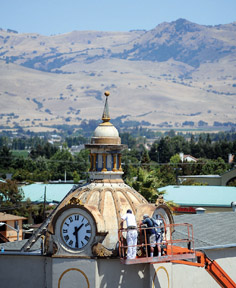Hollister made it onto the map in a big way this month when a story about the rural city penned by Bay Area writer Dave Eggers made it into The New Yorker.
Eggers, perhaps best known as author of the best-selling 2000 memoir A Heartbreaking Work of Staggering Genius—a finalist for the Pulitzer Prize—is a novelist and screenwriter. His works include You Shall Know Our Velocity, How We are Hungry, What is What and most recently Your Fathers, Where Are They And the Prophets, Do They Live Forever?
He also co-wrote the screenplay for the 2009 film Where the Wild Things Are.
Additionally, Eggers helped launch a quarterly literary journal called McSweeney’s, a DVD-based review of short films called Wholpin, a monthly magazine called The Believer, and the Voice of Witness project.
“The year I turned forty-three, I woke up one morning and thought it would be a good day to go to Hollister,” he wrote in the 6,000 plus word piece published in the July 20 edition of the magazine. “It was the kind of trip a middle-aged man takes when his children are at a trampoline birthday party.”
In the article, called “The Actual Hollister,” Eggers speaks of his personal connection to the city where his great-great grandfather, T.S. Hawkins, played a role in its founding. In slow plodding, often lyrical, prose Eggers tells the story behind the Hazel Hawkins Memorial Hospital’s name, introduces Colonel W.W. Hollister and references San Justo Ranch. He also talks of his recent visit, which included a transformative trip to a barbershop where locals thought he was a federal agent or police officer.
But Eggers’ contributions to Bay Area are not just those of a writer. He launched the San Francisco-based 826 National, a nonprofit with chapters across the U.S. that promotes strong writing skills as “fundamental to future success,” according to the nonprofit’s website.
The author and philanthropist also won the 2008 TED Prize, a $100,00 award to make “a wish to change the world,” according to the group’s website. The author asked the community to personally engage with local public schools, according to the website.
Here’s a link to The New Yorker article: http://www.newyorker.com/magazine/2015/07/20/the-actual-hollister.










